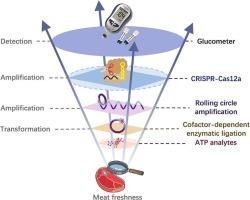Development of a cofactor-dependent enzymatic ligation-triggered rolling circle amplification-assisted CRISPR–Cas12a strategy for ATP detection via a personal glucometer in meat freshness evaluation
IF 6.8
1区 农林科学
Q1 FOOD SCIENCE & TECHNOLOGY
Innovative Food Science & Emerging Technologies
Pub Date : 2025-09-23
DOI:10.1016/j.ifset.2025.104241
引用次数: 0
Abstract
Adenosine triphosphate (ATP), a central molecule in microbial energy metabolism, serves as a critical indicator for assessing food freshness. Herein, we developed a portable and sensitive ATP quantitative platform by integrating a cofactor-dependent enzymatic ligation-triggered rolling circle amplification (RCA)-assisted CRISPR-Cas12a strategy with a glucometer readout. T4 DNA ligase recognizes ATP to form circular DNA templates, initiating RCA reactions that generate amplicons. These amplicons activate CRISPR-Cas12a to cleave ssDNA-invertase conjugates, releasing invertase. The released invertase hydrolyzes sucrose into glucose, which is quantified using a glucometer. Glucometer signals correlate linearly with ATP concentrations from 5 to 200 nmol/L, with a detection limit of 1.08 nmol/L. Furthermore, the linear relationship between ATP levels on meat surfaces and total viable counts was validated. This strategy's accuracy was confirmed through fluorescence recovery experiments and commercial ATP kits, yielding consistent results that highlight the practical application potential of this method for assessing meat freshness.

开发一种辅助因子依赖的酶连接触发滚动环扩增辅助CRISPR-Cas12a策略,通过个人血糖仪检测ATP,用于肉类新鲜度评估
三磷酸腺苷(Adenosine triphosphate, ATP)是微生物能量代谢的核心分子,是评价食物新鲜度的重要指标。在此,我们通过将辅助因子依赖的酶连接触发滚动环扩增(RCA)辅助CRISPR-Cas12a策略与血糖仪读数整合,开发了一个便携式和敏感的ATP定量平台。T4 DNA连接酶识别ATP形成环状DNA模板,启动产生扩增子的RCA反应。这些扩增子激活CRISPR-Cas12a来切割ssdna -转化酶缀合物,释放转化酶。释放的转化酶将蔗糖水解成葡萄糖,用血糖仪定量。血糖仪信号与ATP浓度在5 ~ 200 nmol/L范围内呈线性相关,检测限为1.08 nmol/L。此外,还验证了肉表面ATP水平与总活菌数之间的线性关系。该策略的准确性通过荧光回收实验和商用ATP试剂盒得到证实,结果一致,突出了该方法在评估肉类新鲜度方面的实际应用潜力。
本文章由计算机程序翻译,如有差异,请以英文原文为准。
求助全文
约1分钟内获得全文
求助全文
来源期刊
CiteScore
12.00
自引率
6.10%
发文量
259
审稿时长
25 days
期刊介绍:
Innovative Food Science and Emerging Technologies (IFSET) aims to provide the highest quality original contributions and few, mainly upon invitation, reviews on and highly innovative developments in food science and emerging food process technologies. The significance of the results either for the science community or for industrial R&D groups must be specified. Papers submitted must be of highest scientific quality and only those advancing current scientific knowledge and understanding or with technical relevance will be considered.

 求助内容:
求助内容: 应助结果提醒方式:
应助结果提醒方式:


